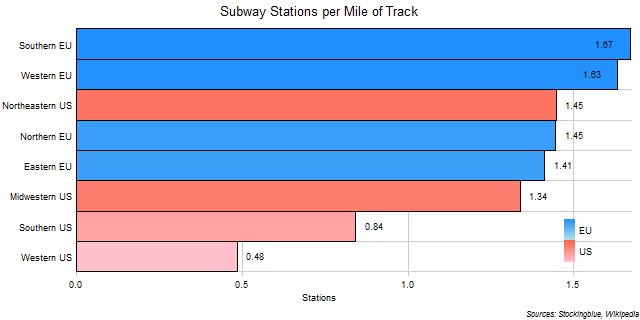
The chart above shows the number of subway stations per mile of track in each region. Clearly, the EU believes in placing subway stations closer to each other than the US does.
Findings
- The difference between the region with the most subway stations per mile of track, the Southern EU, and the region with the least, the Western US, is 1.19.
- The Southern EU has 3.45 times the subway stations per mile of track that the Western US does.
- The Southern, Western, and Northern EU and the Northeastern US each has a higher station density than any subway system in the Midwestern, Western, and Southern US.
- The Eastern EU and the Midwestern US each has a higher station density than any subway system in the Western and Southern US.
- The Western US has a lower station density than any subway system outside of the Western US.
Caveats
- Data is from 2017.
- Hawaii is currently working on building a subway system for Honolulu which is slated to have 1.05 stations for every mile of track. This would raise the West's station density to 0.56 stations for every mile.
- Greece is currently working on building a subway system for Thessaloniki which is slated to have 2.03 stations for every mile of track initially and 1.73 in the second stage. This would keep the Southern EU's station density to 1.67 stations for every mile (slightly raise it if it were not for rounding).
- All figures are rounded to the nearest hundredth.
- The Southern EU consists of Italy, Spain, Portugal, Greece, Cyprus, and Malta.
- The Western EU consists of Germany, United Kingdom, France, Netherlands, Belgium, Austria, Ireland, and Luxembourg.
- The Northeastern US consists of New York, Pennsylvania, New Jersey, Massachusetts, Maryland, Connecticut, New Hampshire, Delaware, Maine, Rhode Island, and Vermont.
- The Northern EU consists of Sweden, Denmark, and Finland.
- The Eastern EU consists of Poland, Czech Republic, Romania, Hungary, Slovakia, Bulgaria, Croatia, Slovenia, Lithuania, Latvia, and Estonia.
- The Midwestern US consists of Illinois, Ohio, Michigan, Indiana, Minnesota, Wisconsin, Missouri, Iowa, Kansas, Nebraska, North Dakota, and South Dakota.
- The Southern US consists of Texas, Florida, Georgia, North Carolina, Virginia, Tennessee, Louisiana, South Carolina, Alabama, Kentucky, Oklahoma, Arkansas, Mississippi, and West Virginia.
- The Western US consists of California, Washington, Colorado, Arizona, Oregon, Utah, Nevada, New Mexico, Hawaii, Idaho, Alaska, Montana, and Wyoming.
Details
The Western EU has the most stations by far, the most track, but has the second most stations per mile of track. The Southern EU has the most stations per mile of track but ranks second in number of stations and length of track. The Western US has the least number of stations and the least number of stations per mile of track but ranks fifth when it comes to miles of subway track. The Southern US comes in last in miles of track and in number of stations but ranks seventh in stations per mile of track.
The Southern and Western US's subway systems with the highest station density, Miami's Metrorail and Los Angeles' Metro Rail respectively, has less stations per mile than the subways with the lowest station density in every other region.
Sources
Wikipedia. 2019. "List of Metro Systems." Accessed February 24, 2019. https://en.wikipedia.org/wiki/List_of_metro_systems.